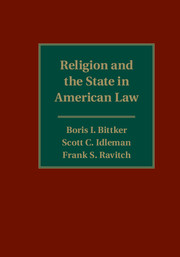Book contents
- Frontmatter
- Dedication
- Contents
- Preface
- 1 History and Introduction
- 2 Church and State in the Nineteenth Century
- 3 Religious Influences and Expressions in Law and Government
- 4 The Establishment Clause
- 5 The Free Exercise Clause
- 6 The Religious Test, Equal Protection, and Free Speech Clauses
- 7 The Definition of Religion
- 8 Church Property Disputes and Church Schisms
- 9 Contracts
- 10 Taxation
- 11 Employment
- 12 Land Use
- 13 Torts
- 14 Criminal Law and Process
- 15 Family Law
- 16 Public Education
- 17 Religious Symbolism on Government Property
- 18 Special Contexts: Prisons and the Military
- Appendix A Federal Constitutional Provisions
- Appendix B State Constitutional Provisions
- Appendix C Selected Federal Statutes 910
- Index
5 - The Free Exercise Clause
Published online by Cambridge University Press: 05 October 2015
- Frontmatter
- Dedication
- Contents
- Preface
- 1 History and Introduction
- 2 Church and State in the Nineteenth Century
- 3 Religious Influences and Expressions in Law and Government
- 4 The Establishment Clause
- 5 The Free Exercise Clause
- 6 The Religious Test, Equal Protection, and Free Speech Clauses
- 7 The Definition of Religion
- 8 Church Property Disputes and Church Schisms
- 9 Contracts
- 10 Taxation
- 11 Employment
- 12 Land Use
- 13 Torts
- 14 Criminal Law and Process
- 15 Family Law
- 16 Public Education
- 17 Religious Symbolism on Government Property
- 18 Special Contexts: Prisons and the Military
- Appendix A Federal Constitutional Provisions
- Appendix B State Constitutional Provisions
- Appendix C Selected Federal Statutes 910
- Index
Summary
Introduction and Note on Smith and Its Aftermath
Central to the liberty of Americans is, and has long been, freedom of religion. This is true historically, given the country's tradition of religious dissent and tolerance since at least the eighteenth century. It is true demographically, given the diversity of faiths that have emerged and today coexist across the national landscape. It is true aspirationally, as manifest in the “Four Freedoms” of both the 1939 New York World's Fair and President Franklin D. Roosevelt's 1941 address to Congress. And it is true constitutionally, as embodied in the First Amendment, which protects religious freedom both directly, by barring the prohibition of its free exercise, and indirectly, by barring laws respecting an establishment of religion.
The first of these constitutional protections, the Free Exercise Clause, is the focus of this chapter; the latter, the Establishment Clause, is addressed in Chapter 4. The Free Exercise Clause, which provides that “Congress shall make no law … prohibiting the free exercise [of religion],” protects both freedom of religious belief or profession and, as the text indicates, freedom of religious exercise or conduct. However, though it has often been said that religious belief is absolutely protected, case law and common sense dictate that religious exercise – defined by one court as “the robust putting into practice of a person's religious beliefs” – is protected only to a point. That point is effectively determined by a balancing of the respective interests of the free exercise claimant and of the government or of the public that it represents, where the precise balance or level of judicial scrutiny will vary based on the claimant's evidentiary showings.
This chapter presents an overview of this balancing methodology from the required components of a free exercise claim, to the ways in which the government may or must respond to such a claim, to the different levels of judicial scrutiny that have been recognized, as well as to the factors that can determine which level of scrutiny may apply. In addition, the chapter briefly addresses the forms of religious accommodation available under the Free Exercise Clause as well as the doctrines of religious institutional autonomy that are grounded, at least partly, in that provision.
- Type
- Chapter
- Information
- Religion and the State in American Law , pp. 210 - 288Publisher: Cambridge University PressPrint publication year: 2015



